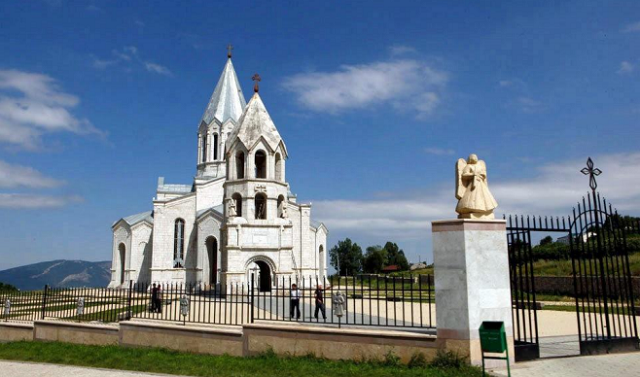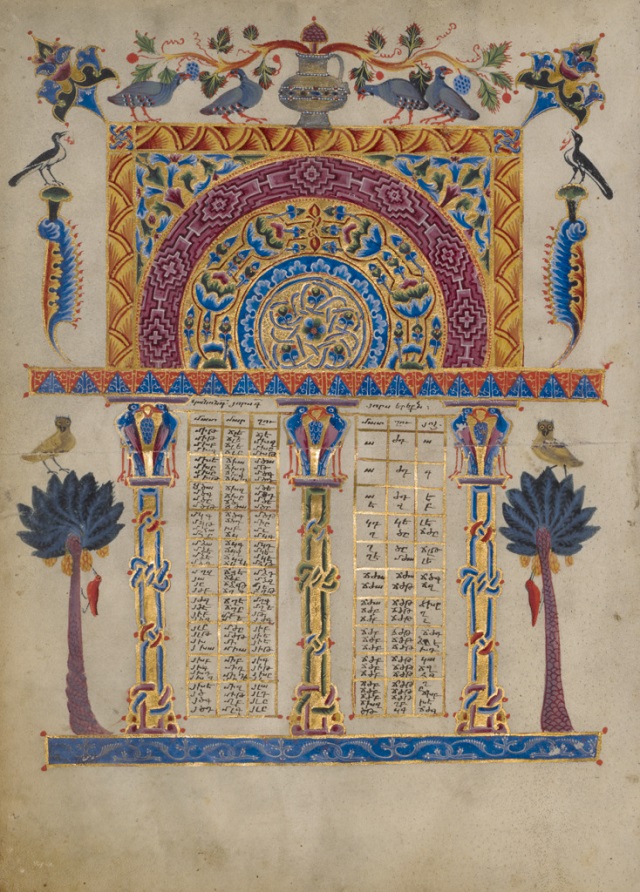The Armenian Mirror-Spectator. BOSTON — Conscientiously attributing artistic and cultural goods to their creator, culture and nation state is dependent on nuanced analyses.
Dr. Christina Maranci, Arthur H. Dadian and Ara T. Oztemel Associate Professor of Armenian Art at Tufts University and author of The Art of Armenia: An Introduction, mentions one of the many ways to identify a work is by its provenance: the chronological history of its ownership which, in some cases, can be traced back to the artist.
Another identifier is its similarly monikered provenience, or the geographical and archeological find spot. Key indicators specific to a cultural tradition, creative process, artistic movement, group of people, or a record of the artist such as their signature can also be used. Visual similarities to other known works, often in conjunction with the dating and identification of the materials of a piece, can additionally establish it chronologically in a latticework of cross-cultural artistic influence. This “constellation of ways” through which a piece can be identified is also used to establish the context of its creation.
Maranci states, “You have to hope that these criteria would be considered by museums,” and that they would then be able to identify an object as having an Armenian provenience, an Armenian creator, or as being of an Armenian style or tradition. However, in many major museums in the West, it is, “quite common,” that this isn’t the case.
Read also
The impetus? A lack of education on Armenian art in most American and European universities which is exacerbated by prejudice.
The gaze of Western art history has been historically preoccupied with Euro-centric art and influence, too often leaving behind the cultural histories of regions outside of this immediate and obvious sphere.
“Despite some very important recent contributions,” confirms Dr. Heghnar Zeitlian Watenpaugh, Fellow of the John Simon Guggenheim Memorial Foundation, professor of Art History at the University of California, Davis, and author of The Missing Pages: The Modern Life of a Medieval Manuscript, from Genocide to Justice, “there are still enormous gaps in our understanding of the history of Armenian art.”
Maranci notes how art history has become more inclusive of non-Western cultures since the 1980s but is still “not integrating many major important and beautiful traditions.” Today, this is “the shape of art history,” she notes: art historians and curators are not trained on Armenian art. “So where would the average curator come into contact with an Armenian work?”
Attribution within Western Institutions
In Western institutions, the ramifications of this ignorance is seen in Armenian art often being attributed using regional labels such as Greek, Byzantine, Turkish, Ottoman, South Caucasian, Ancient Anatolian, Crusader, Middle Eastern, or Islamic. Each label has specific uses and can be at least partially accurate, reflecting how Armenian history has not been isolated from the influence of other cultures. Rather, it has actively communed with them for centuries to the extent that, as Maranci re-centers, “Through Armenian art, you’re going to learn about Greek sculpture, Roman temple architecture, Islamic art, and Byzantine art. You’re going to learn about Western Europe. You’re going to learn about East Asian art…”
However, Dr. Vazken Davidian, Faculty of Oriental Studies and Calouste Gulbenkian Postdoctoral Fellow in Armenian Studies at Oxford University, acknowledges these labels lack “an understanding of the cultural networks and exchanges that have influenced Armenian artists or craftsmen and women, and how these Armenian objects, individuals, and visual vocabularies have influenced and enriched those of the wider region.”
In context, they often are encouraged by negligence and contribute to ignorance concerning Armenian artistic creations rather than appreciation for the various populations which have lived within Armenia, the identities of the artists who have created in Armenian styles, the dance of cultural exchange Armenia embraced, and the breadth of ethnically Armenian artists throughout the world, he continues. “Where works are displayed is of course central to how they are displayed,” he notes – and in the West, institutional mislabeling is endemic of academic whitewashing.
Maranci makes it clear that even when there are numerous indicators which would normally signal a work as being Armenian, if the dealer, seller, or curator has not been critically exposed to Armenian culture, it may still be mislabeled. This lack of education often leads to instances of unacceptable oversight when “there is this beautiful object that was labeled as Islamic” with no mention of Armenian maker or origin, “but you turn it around and there’s an Armenian inscription on it.”
This is not to gloss over nuance — there are many unknowns when it comes to art attribution. Maranci shares the status of many beautiful silver vessels which were excavated at Erebuni, an Urartian site occupied during the 4th c. and 5th c. BCE which has been historically Armenian. Though the provenance is known, “We don’t know [who made them]. We don’t know if they were the product of trade. We don’t know if they were commissioned. We don’t know the identity of the artist,” she says. Even when the provenance is known, the identification of its creator may be elusive. For example, as Davidian points out, “if a carpet style is common among Kurds and Armenians in the Moush region, it is difficult to say who the creators were.”
Attributing art to Armenians is further nuanced by ethnically Armenian artists who themselves did not identify principally as Armenian.
“For example, particularly Armenian nobles in the medieval period understood themselves primarily as members of their family,” Maranci contributes. Even in modern times, Hrag Vartanian, critic, curator, editor-in-chief and co-founder of Hyperallergic, reveals, “a lot of modern artists in the US for instance, did not want to identify as Armenian because they didn’t see benefits,” due to the initial status of Armenians as non-white immigrants to this nation, which threatened deportation. Attribution is conversely further obfuscated when art is produced by diasporic Armenians, for in these cases the ethnicity of its creator may need to be recognized in addition to its context of creation.
Davidian adds: “Reclaiming what is or is not produced by Armenian artists or craftsmen or women does not mean erecting proverbial ‘walls’ around objects such as the head of the goddess Anahid in the British Museum or a ceramic vase or tile from Kutahya and declaring them as ‘uniquely Armenian.’ It is about understanding the context of their production and the processes and exchanges with cultures near and far which have influenced them — just as critically defined Armenian art has influenced other cultural processes. Only then can we properly reclaim these… mis-identified or stolen objects as part of our own cultural heritage.”
Turkish Influence
“The presentation of an artistic or historical object as ‘Armenian’ or not during the 20th century and today is very strongly intertwined with the legacy of massacre and genocide and how the history of violence” has been and has continued to be “narrated and silenced,” says Davidian. He adds that due to the total appropriation, or Turkification, of Armenian art which followed the Hamidian Massacres and Armenian Genocide, many ethnically Armenian cultural goods including rugs, ceramics, embroidery, woodwork, and other crafts, “especially items lacking signature or identification marks of their producers,” are still “presented largely as Turkish or Kurdish art.”
This history of Turkification and continued academic negligence regarding Armenian art and cultural artifacts has affected the degree to which institutions are able to identify those objects that came to them as a product of theft or state-sanctioned looting. This problem extends to many of the objects remaining in catalogs from the early twentieth century, which are most likely related to the trafficking of goods after the Genocide.
Additionally, Armenia or Armenians may not be mentioned in attributional labeling because of “certain political agendas that would be pushed in by modern states” regarding their relations with the Republic of Turkey, Maranci explains. This motivation has caused Armenian art to be exhibited by ahistorical monikers in Western institutions such as a gallery entitled “Ancient Turkey” in the famed British Museum. (At the behest of a petition organized by Gagik Avagyan, the gallery was renamed “Anatolia and Urartu” in 2013.) However, “one cannot always assume, fairly, that the sort of sinister implications go all the way down from the donor or the seller to the museum to the curators. We can’t implicate the curators necessarily, but we can educate them” – in these cases, first on the history of Turkish violence against Armenians and its subsequent denial, then on the violence committed against our cultural heritage and its subsequent denial.
Until Genocide denial is stifled and the background education regarding Armenian culture is incorporated into curricula, Dr. Maranci expresses these other labels are always a red flag: “They sound like they’re actually pushing something aside… Why is that [label] being used? Why are they not using the term ‘Armenian’?”
Impact of the Western Gaze on Armenian Art
This ignorance and prejudice regarding Armenian art has drastic implications on how it is presented. Vartanian observes, “any discussion of Armenian art becomes very broken, fragmented, and it doesn’t actually take it on its own terms, but often fits it into bigger categories that end up instrumentalizing Armenian art and making it always secondary rather than central to the conversation.” Thus, most of these mis-attributed Armenian objects remain deemphasized in the storage of other cultures – further erasing Armenian art and any chance it has of being seen publicly – let alone through an Armenian lens. Tucked between the cracks, a wealth of Armenian art resides within the palms of those hands which participated in cultural exchange with Armenia for years – utterly peripheral.
This narrative skews perception concerning Armenian art and cultural goods – from their significance in relation to neighboring artistic traditions to “actually developing a real sense of how big this corpus is” Dr. Maranci states. As it stands now, “how can we know how much [Armenian art] is out there?” For scores of Armenian works have already been discovered and stored but remain buried within the storage of institutions which have erased Armenian art for decades. “I would actually say there’s probably a lot more out there than we know.”
Cataloging works through a Western lens which is blind to Armenian culture not only shrinks our corpus but also flattens the vibrance of our historic tangible culture. Mr. Vartanian declares, “We are never going to get a full picture of Armenian art when we use Western ideas around art because all the best Armenian art isn’t just oil on canvas or sculptures,” as is often heralded in the Western canon. “Some of it is handicraft. Some of it is dance. So we have to expand our notions of art to incorporate those worlds within those boundaries.” Vartanian further expresses that this blasé attitude toward Armenian art has “created Armenians that only know little parts of our history and end up feeling like there isn’t a significant history of Armenian art.”
Even our perception of the function of Armenian art has been harmed by the Western lens: “a lot of the most precious artifacts of handiwork and art were actually stored and shown only on precious occasions for people as an almost individual relationship [with them] which is very much against the traditional idea of how we see art, at least in modern American art history,” comments Vartanian.
Cultural and Artistic Reunion
Sometimes, persistence in correcting the correct identification of a work of art pays off.
This past February, five years after the historic settlement between the J. Paul Getty Museum and the Western Prelacy of the Armenian Apostolic Church of America regarding the provenance of the Canon Tables of the Zeyt’un Gospels, a new model of attributional recognition was exercised in the collection of the Walters Art Museum in Baltimore, Md. A collaborative week-long inspection of their 18th-century Jeweled Gun of Sultan Mahmud I was undertaken by Armenian experts and those at the Walters Museum at the request of the National Museum of Armenian Ethnography and the History of the Liberation Struggle in Araks, Armenia to re-examine its attribution. At its conclusion, the artifact’s label was revised to attribute the jeweling of the piece to Armenian Christian Hovhannes Agha Duzian while maintaining recognition for the many other artisans who were integral in its creation.
Davidian identifies that for continued productive change, we must “make sophisticated arguments because the contexts of art production, like all intellectual activity, whether Armenian or not, are complex and don’t take place in a vacuum… We must find a way of proposing labeling practices that are inclusive and true of all their components and contexts in which they were created.”
In the meantime, Maranci declares that Armenian viewers “may be the closest thing to an expert that these objects have ever seen.” She emphatically recommends perusing museums’ online catalogs – which have recently expanded largely due to COVID-19 – for Armenian art, arguing that Armenian communities have both the ability and responsibility to exercise their familiarity with Armenian language and history by educating their local institutions. In this way, Armenian communities have the capacity to, after years apart, reunite these timeless works with the corpus of Armenian art and include them in the legacy of Armenian cultural history.
(Isabelle Kapoian is a student of economics, art history, and international affairs in the Class of 2021 at the University of New Hampshire. She holds professional interests in cultural property law and art market economics, plays the harp, and most enjoys reading and contributing to the Arts & Culture section of the Armenian Mirror-Spectator. Isabelle has participated in the Armenian Assembly’s Terjenian-Thomas internship program in 2019 in Washington, D.C. and the AGBU’s Global Leadership Program during this past summer, is co-president of her university’s Middle Eastern Cultural Association, and sings in the choir at Sts. Vartanantz Church in Chelmsford, MA. She has been the summer intern at the Armenian Mirror-Spectator through the Armenian Students Association Journalism Internship.)
By Isabelle Kapoian
Special to the Mirror-Spectator
Main caption: Prof. Christina Maranci






























































